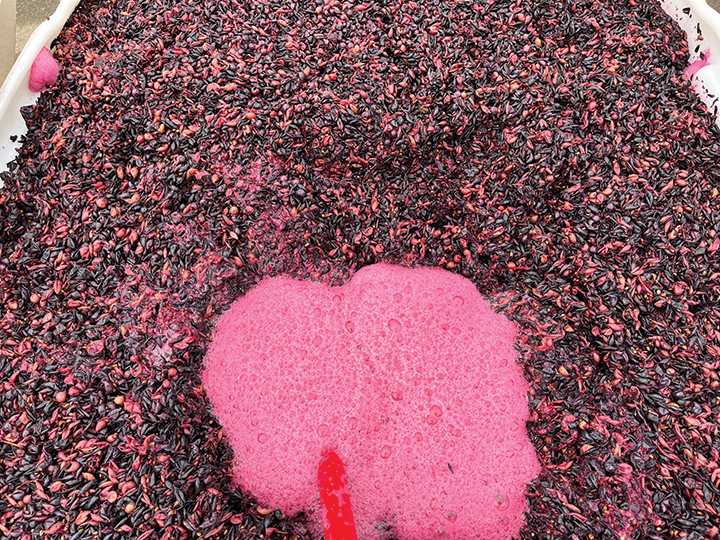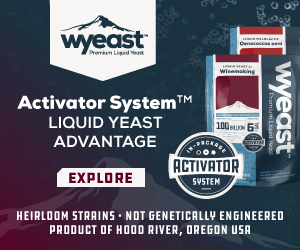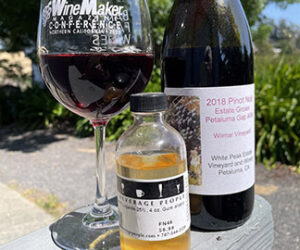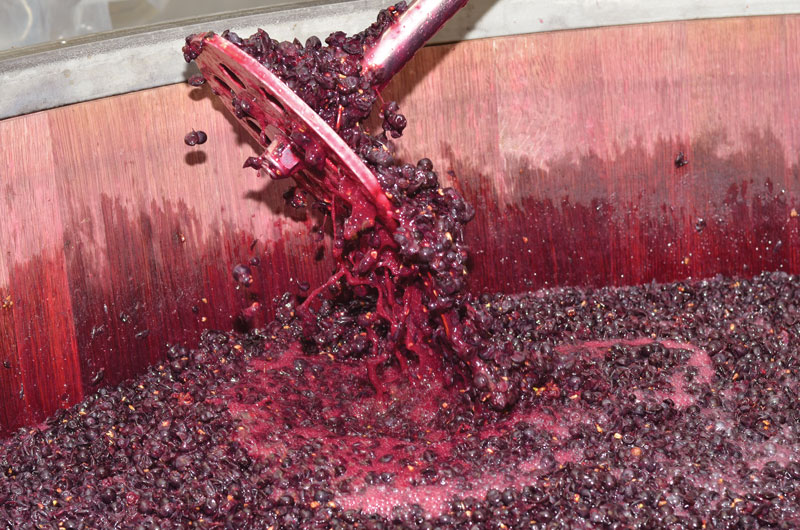It may be argued that the most critical decision points in all of winemaking occur at the juice stage prior to alcoholic fermentation. The opportunities available during this period are also perhaps the least appreciated by many winemakers.
In my winemaking classes, I address a number of misconceptions my professional colleagues cling to. Before we get started discussing specific techniques, then, let’s explode a few myths.

1. Brix is a useful indicator of ripeness. Nope. Famed Napa winemaker Matt Glynn devoted his doctoral thesis at UC-Davis to a single 123-berry cluster of Napa Cabernet Sauvignon.1 One of his most interesting findings was that the Brix of the individual berries varied by 10 percentage points. Furthermore, Brix has more to do with humidity than maturity, which is why in the dry air of California, it is often beneficial to pick at elevated Brix and water down.
2. Alcohol is a solvent for color and flavor. Not so. In Roger Boulton’s landmark paper on co-pigmentation,he demonstrates that anthocyanins are not soluble in alcoholic solution and need to form colloids in the must in a one-to-one ratio with monomeric phenols.2 Tannin polymers such as VR Supra don’t work. More about co-pigmentation soon.
3. Small berries make richer wine. Also not true. Matt Glynn showed that berry size is dependent on seed number and so is anthocyanin content. Berries with no seeds fail to color up at all — rain at bloom is often the culprit. In Matt’s study, the largest berries had the most color content.
Must Preparation
Most musts need to be acid corrected. While it takes me hours to explain why, the short answer to acidification of elevated pH musts such as we normally see in California is usually to add tartaric acid to bring both reds and whites to pH 3.45. Take the pH immediately upon crushing and use as a rule of thumb to add 0.5 g/L per 0.1 pH unit shift required.
Every crush, I generate hundreds of calculations for Brix and acid corrections. In dry regions like California and Colorado, pHs often require large additions to adjust juice from pH 4 or higher, which can often require over 2.0 g/L of tartaric acid. Clients skittish about such a large addition will add half what I advise, then call me to report that their pH and titratable acidity (TA) are the same as before. Usually the problem stems from the high potassium content of the must, which remains dissolved because the pH is so far away from the peak of the bitartrate curve at pH 3.65. Adding half the acid may shift your pH to the range of 3.75–3.80 where precipitation can occur, but above pH 3.65, this precipitation will cause the pH to rise, sometimes right to back where you started — say pH 4.0 and a TA of 7.0 g/L. But you have now dropped out a lot of potassium, and additional tartaric can get you to the target, which by now has shifted up due to skin contact. Once you get into the range near pH 3.65, you’ll experience large amounts of the white precipitate, potassium bitartrate, which will bring your TA down.
This only works if your problem is high potassium. For cool regions and in many hybrids, high pH is caused by high malic acid, for which tartaric acid adjustments won’t work. The way to find out is to take, 500 mL of juice prior to skin contact and acidify it with tartaric until the pH hits 3.45. Then pour it into a 12-oz. (355-mL) water bottle, squeeze a bit to allow for expansion, and freeze it overnight. In the morning, you should see lots of precipitate. Thaw the juice and measure the pH and TA, which should have dropped agreeably. Now you can repeat the dose in the main lot.
For high-malic acid musts, you have a lot of choices, including water amelioration, double-salting,3 malate-consuming yeasts, malolactic via bacteria, potassium bitartrate precipitation through chilling, and as a last resort, potassium carbonate. Of course, waiting for the acid to come down before harvesting is always the best way to start if nature cooperates.
Cold soaking pre-fermentation was pioneered in the ‘70s by Sergio Traverso at Concannon Vineyards in Livermore, California, for Petite Sirah in order to extract anthocyanins (which are water-soluble) without picking up tannins (which are not, and require alcohol to extract). The result is that today, Concannon is the largest producer of Petite Sirah in California.
While Sergio’s idea was very good, in general, I think cold soaking often does more harm than good. Despite that it’s a time when the must is extremely vulnerable to spoilage, many do it for increased complexity due to the many species of yeast and bacteria that can thrive below 1% alcohol and add interesting flavor notes. Sometimes a bit too interesting. Organisms like Brettanomyces and Lactobacillus kunkeei can run away during this period.
Recently, several suppliers have developed versions of the benign non-Saccharomyces yeast Metschnikowia pulcherrima, which can take over a cold soak and kill off other organisms, then gracefully recede when Saccharomyces is introduced. This is a godsend, but also precludes the thriving of other organisms, thus leading to final products that are less complex but more sound.
One advantage of this approach is that it prevents cold soaks that acquire very high levels of biogenic amines such as histamine, putrescine, and cadaverine, to which some people are highly allergic.
How you get to the cold temperatures required to suppress fermentation (<59 °F/15 °C) is worth discussing. Assuming the small practitioner doesn’t have access to the must-chilling equipment commercial wineries use, the most efficient way to get started is to pick at the diurnal minimum temperature, which occurs at dawn. Further chilling can be achieved with dry ice, but it takes much more than is usually employed.
When a pound of dry ice sublimes, it takes up 600 BTUs of heat. One pound of must requires about 1.2 BTUs to chill 1 °F (~0.5 °C). Thus, to lower, say, 1,000 pounds of must from 60 °F to 45 °F it takes a minimum of 30 pounds of dry ice, assuming 100% efficiency of heat transfer. (For our readers outside of the U.S., those numbers translate to a requirement of 13.6 kg of dry ice to lower 450 kg of must from 16 to 7 °C.) In practice, you need twice that amount. You’re better to get up early and pick cold.
Later in this article I’ll discuss an alternative to cold soaking known as “accentuated cut edges,” which eliminates the risks and inconveniences of cold soaking with generally better results.
Co-pigmentation Strategies
As I mentioned at the start of this article, the notion that alcohol can extract color is simply wrong. Diluting musts to 23 °Brix or less and setting up an effective co-pigmentation strategy will give you your densest color and flavor.
Zinfandel, Pinot Noir, Barbera, and the lion’s share of hybrid reds lack the co-factors Boulton showed were necessary to extract color into colloids. These colloids result from the “ring stacking” of the apolar pi orbitals that circle above and below the six-carbon double-bonded ring characteristic of all phenols. The reason anthocyanins can’t form colloids on their own is that at low pH, they ionize into a positively charged flavylium form (this is the red colored form) and thus they repel each other. They need an uncharged phenolic spacer molecule between them.
Many strategies can be employed to provide supplemental co-factors. Winemaking traditions throughout Europe employ the addition of aromatic white skins: Viognier with Syrah in the Rhône, Trebbiano with Sangiovese in Chianti, and Malvasia with Tempranillo in Rioja. These grapes have high terpene content (think Muscat, Riesling, or Vignoles). Since birds and bees delight in snacking on them, they have all developed high phenolic content in order to cauterize predator wounds, just as you see in apples and bananas.
If I’m making white wine from aromatic fruit, I save the skins until the low-tannin reds come in. My rule of thumb is to use 10% per fresh weight ton. I will either freeze them or ferment them to dryness using a red wine yeast, thus inoculating the red when I later add them. This concoction resembles Worcestershire sauce, so pitching into a perfectly good red must is a little scary, but it works.
High-tannin reds can also be used to supplement lighter reds. Field blends in Zinfandel vineyards interplanted with Petite Sirah, Alicante Bouschet, Carignane, etc. have been around for over a century. I learned from Paul Draper at Ridge Vineyards in California’s Santa Cruz Mountains AVA to use 10% Petite Sirah in all my Zins. Since the tannins form early in grape development, ripeness doesn’t matter – just make sure to crush everything together so it co-ferments.
Another trick I love is to use high-quality untoasted oak chips in the fermenter. I find the Boisé France Bois Frais Pumpable the most reliable, and I use a lot: 0.7–1.3 oz./gallon (5–10 g/L). Since they aren’t toasted, they don’t impart barrel flavors. They contain about 25% ellagitannins (a mannose with five gallic acids attached), and their main function is as a rich source of this triphenol, a great co-pigmenter and antioxidant.
Water Into Wine
Boulton showed that co-pigmentation doesn’t work at high alcohol because it destabilizes the colloids. In dry climes like California, Colorado, and Eastern Washington, evaporation causes grape Brix to climb to levels where color extraction fails, resulting in hot, thin wines with heaps of dry tannin and poor longevity.
Unlike pH, which should be measured at the crusher prior to soaking, proper Brix determination requires a 24-hour soak. I always replace the evaporated water so that I end up with alcohol around 13.5%. The conversion of Brix to alcohol is about 0.61 in cool coastal regions and closer to 0.59 in climates like the warmer Central Valley of California.
Brix is a weight-to-weight ratio. Since water weighs a lot less than high-Brix must, a proper calculation requires a density table look-up. I have done this for you in the table below — just use this table for your additions per half ton of red must, assuming 8% skins:

I might sound cavalier about these large water additions. I have a hard time persuading clients to get their final alcohols under 14%, which means diluting below 23 °Brix, as we always picked in the good old days. That’s because they don’t understand colloid chemistry. They’re afraid that they’ll dilute the flavor and density, but the opposite is true.
Anthocyanin pigments and other flavor components are sparingly soluble in wine and can only be extracted into co-pigmentation colloids. A co-pigmentation colloid is a coagulation of phenolic rings driven together by water activity. At high alcohol, they don’t exist at all. Believe it or not, at lower alcohol, the wines become denser and more highly extracted. Meaning more wine and better wine.
Additionally, the esters, terpenes, and thiols in both red and white wine are hydrophobic, so the high water activity at low alcohol levels pushes these elements into the gas phase, increasing olfactory intensity. Their fruity and flowery aromas are further enhanced because they are not masked by alcohol’s heat. German Rieslings at 8% are some of the most aromatic wines in the world.
Sweet Spotting Low °Brix Musts
In cool climates, chaptalization is a controversial topic. The time-honored practice of must amelioration, i.e., the addition of as much as 35% water by volume to lower acidity, may lead to even lower alcohols. This is not necessarily a bad thing. The lower the alcohol, the better the extraction of color and flavor (due to high co-pigmentation colloid stability) and the more the water-hating (hydrophobic) esters, thiols, and terpenes enhance the aroma. For some styles, however, low-alcohol wines can appear thin and salty.
Napoleon’s Minister of Agriculture, one Jean-Antoine Chaptal, recommended the planting of sugar beets (much friendlier to French growing conditions than sugar cane) for addition to grape must at 10–20 g/L to boost ABV by a percent or better, finding a 12% ABV wine more pleasant than 11%, thus ushering in the process of chaptalization.
In calculating these additions, bear in mind that Brix is a weight-to-weight ratio and that the added sugar increases the volume. Thus you iterate successive proposed additions. Say you have a must of 17 °Brix and you want 20. A liter (1,000 mL) of 17 °Brix has 170 grams of sugar. Start by figuring you’d need to add 30 grams, so now you have 200 grams. But your volume has expanded by roughly 30 mL, so you really have about 1,030 mL, so your °Brix per liter is 200 g x (1,000/1,030) = 194 g/L = 19.4 °Brix, so you need to add a bit more, and a bit more after that. See why I get crush consulting clients?
The problem with chaptalization is there’s no way to predict the exact balance point where the alcohol provides a harmonious balance. We call this mysterious phenomenon “sweet spots.” Nobody knows why, but like musical chords, there are certain ABVs where everything rings harmoniously that can’t be precisely predicted in advance.
Because sugar is cheap, my recommendation is to chaptalize to get into the low end of the range of the ABV you think you want. Then after the wine is made, buy some nice clean vodka or Everclear and set up a tasting series at 0.1% intervals, laying out ten or twenty 50-mL glasses with a control and increments of 0.1% using a graduated 1.0-mL pipette (for example, add 0.06 mL, 0.12 mL, 0.18 mL, 0.24 mL, 0.30 mL, etc.) gather a couple friends and see if you can agree on the best wine. It’s an eye-opening experience.
Overcoming Pectin
Because of the wax cuticle surrounding a grape, no extraction can occur through the berry’s outer surface. Color, flavor, and tannin need to fight their way through the inner pectin layer. The longer this takes, the poorer the wine will be. Pectinolytic enzymes are a long-standing solution for liberating skin extractives.
Elevated temperatures can aid extraction and promote color stability. An advantage of small lot fermentations is that they can be taken into the 90s °F (32–34 °C) without running away, whereas large commercial fermentations must be kept to temperatures below this, lest toxins created in hot spots in the cap cause them to cook and stick.
A wonderful new technique conceived by renowned Australian viticulturalist Richard Smart and developed by Angela Sparrow at the University of Tasmania goes by the name of Accentuated Cut Edges (ACE). Smart’s idea was that when a grape is crushed, it bleeds color and flavor rapidly along the cut edge, but the edge isn’t long enough to make a difference in the extraction rate. So, he and Angela experimented with an immersion blender. They determined that if you got the speed right, it could chop the skin into eight or ten pieces without cutting the seeds.4
I was entering my 58th vintage when I tried this technique in 2019, so I thought I knew a little something about winemaking. Yet I watched my wines take a quantum leap in quality. In 2020, I ran trials at nine wineries on both coasts with spectacular results. One of the most impressive was the effect on Riesling and Sauvignon Blanc chopped and taken direct to press. We observed a fantastic boost in aromatics without the astringency you’d get with skin contact.
I recommend the Robot-Coupe CMP400-VV immersion blender with the variable speed set to 3 out of 10. With a protective bell cover splash guard, it will run you about $1,000. It takes about five minutes to chop a half-ton bin, but it’s a long five minutes, so maybe recruit that big kid who cuts your grass.
Carbonic maceration is a technique invented in Beaujolais for its “nouveau” wines intended for very early release rather than age-worthiness.
Making these wines can be a fun change of pace and can be easily accomplished on a small scale. All you need is a plastic garbage can with a lid and a cannister of CO2. I’ve done it many times. The alcoholic and malolactic fermentations proceed using the grape’s enzymes rather than yeast and bacteria. It’s sort of the opposite of ACE.
The wines are artificially fruity due to the production of styrene and amyl esters. The wines tend to be light in color with gritty tannins, more rustic than elegant. Typical varieties are Gamay and Grenache, though any cultivar can be used.
The clusters are left whole and stacked in the fermenter. The space around the clusters is then flooded with carbon dioxide, either from a cannister or with dry ice. The rule of thumb is that 44 grams gives you one mole. Translation: A pound of CO2 gives you about 50 gallons of gas (0.45 kg gives you about 190 L). Thorough gassing prevents the formation of mold, so don’t scrimp. Any time you open the fermenter to peek in, you’ll need to re-gas.
The grapes are left in a sealed container for two or three weeks — enough time for most of the conversion to take place. At that point, the mass is crushed or foot-stomped, yeasted, and fermented to dryness. Use paper chromatography to check for completeness of malolactic fermentation, settle, and bottle away for drinking in the near future, commonly chilled, with pizza, fried pickles, and other greasy foods.
References:
1 Glynn, Matthew Charles. “Distribution of °Brix, Berry Weight, Seed Number, Anthocyanins, Total Skin Phenols, Skin Hydroxycinnamates, and Skin Flavonols in a Cabernet Sauvignon Cluster.” University of California, Davis, 2003.
2 Boulton, Roger. “The copigmentation of anthocyanins and its role in the color of red wine: A critical review.” American Journal of Enology and Viticulture 52.2 (2001): 67-87.
3 Jed Regan, Double Salt Microfiltration. https://youtu.be/ncnWISVUPWs?si=Xz6Go6ja876i9BIW
4 Sparrow, Angela M., et al. “Accentuated cut edges (ACE): Effects of skin fragmentation on the composition and sensory attributes of Pinot noir wines.” American Journal of Enology and Viticulture 67.2 (2016): 169-178.





